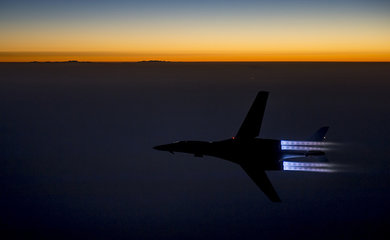When the Islamic State (ISIS) group symbolically dismantled the Skyes-Picot border which had long separated the modern states of Iraq and Syria in the middle of 2014, following its takeover of large swaths of Iraqi territory, the word “partition” was on many people’s lips. Indeed TIME Magazine had a not too subtle cover story which simply read ‘The End of Iraq’.
Over a year later we hear similar pronouncements. In recent days one could hear and read observers of the present crisis diagnose the potential permanent end to both Iraq and Syria. In Iraq the Shi’ite cleric Ayatollah Ali al-Sistani declared that if the government in Baghdad does not reform substantially Iraq may indeed fragment. A recent, now broken down, ceasefire between the regime of Bashar al-Assad and the Shi’ite militia Hezbollah on the one side, and the self-described Army of Conquest (an umbrella Islamist force which includes the al-Qaeda affiliated Jabhat al-Nusra) on the other led to this salient question: Are the lines of a not too distant Syrian future being drawn along the present battlefronts?
That ceasefire came as a result of two isolated Shi’ite majority villages in Syria’s northwest Idlib Province loyal to the Assad regime coming under attack from the Army of Conquest while at the same time Nusra forces near Damascus were being uprooted from the strategically important city of al-Zabadani by Hezbollah and Syrian military forces. The following population-swap was consequently proposed: Those Islamists under siege in Zabadani, along with many of that cities predominantly Sunni residents, would be allowed safe-passage up north in return for those besieged Shi’ites in the north being safely relocated down south where they could be more easily protected by the regime. This corresponds with the evident policy on the part of Assad in recent months of securing a rump state in which his regime can eek out a continued existence. Something which would indeed constitute a long-term, perhaps even permanent, partition of the Syrian state.
The so-called Islamic State which has managed to conquer large swathes of both Iraq and Syria still remain a force to be reckoned with. How Iraq and those supporting it in its fight against this emergent terror state can re-establish the old borders is not presently clear.
Speaking hypothetically the Syria-analyst Joshua Landis has argued that keeping the territory upon which ISIS has imposed its state might solve a lot of broader problems in that region. Obviously not with the same rulers. Landis believes the territories currently conforming to that terrorist entity are reflective of the desires and interests of many of the Sunnis living within them. His ideal solution would therefore entail giving the Sunnis independence within, roughly, the same parameters of the so-called Islamic State and help them rid that area of the dangerous Islamist forces of ISIS. Then recognize that state instead of destroying it “in the name of upholding the borders that no longer really meet the interests of the people” residing in them.
Landis was, of course, making this proposal on very hypothetical grounds and offering this as a possible solution which could be introduced in a world without certain political constraints. But nevertheless his point does indicate that the territories upon which the Islamic State has been established do conform to areas many think would be best suited for a partition based on sectarian schisms. The areas ISIS conquered in Iraq, most of Anbar and Nineveh provinces, are both Sunni majority parts of Iraq – the latter province of course being home to Mosul, Iraq’s second-city and largest Sunni-majority metropolis. In Syria ISIS has also mostly taken over Sunni-majority parts of the country (unlike Iraq however Syria is a Sunni-majority state).
The tangibility of the Islamic State is also something that should also be taken into account. Today we see Syrian traders from ISIS’s so called “capital city”, Ar-Raqqa in Syria, are moving back and forth between there and Mosul in a clear demonstration that the old frontiers themselves now exist only in theory and certainly not in practice. Indeed former recruits of ISIS have spoken about how the organization likes to move them between Iraqi areas and Syrian ones to try and demonstrate that their state is rising and that the old borders are no more. Many cases like those came after ISIS closed off Mosul from the rest of Iraq and opened it up to its territories in Syria. New de-facto frontiers have, for the meantime anyway, split Iraq and replaced the old lines that for so long marked the dividing line between it and Syria. The longer this Islamic State polity endures and survives, however ruthless, oppressive and destitute an entity it is, the harder it will be to re-establish and reinforce the old Iraq-Syria border. And if fears of partitions in Iraq and Syria are indeed realized over time the territory upon which ISIS has erected its terror state could indeed become a new independent Sunni-majority state between Aleppo and Baghdad, possibly situated east of a rump state controlled by Assad and west of a Shiite-majority state (in the Iraqi heartland) and an independent Iraqi Kurdistan.
While one wouldn’t necessarily like to see the region break-up in this way one is nevertheless reminded that it is certainly a possible outcome of the present crises afflicting it and its people.

